Creamy Cacio e Pepe Risotto : A Modern Italian Recipe
This Cacio e Pepe Risotto marries two great Italian classics: creamy risotto and a traditional cacio e pepe. Having been to Italy a handful of times (and to Rome, where cacio e pepe comes from) twice, I can confidently say that I am an expert on the true flavors of the classic Italian pasta dish. This risotto cacio e pepe is a simple dish with a delicious, creamy texture thanks to plenty of pecorino romano cheese!
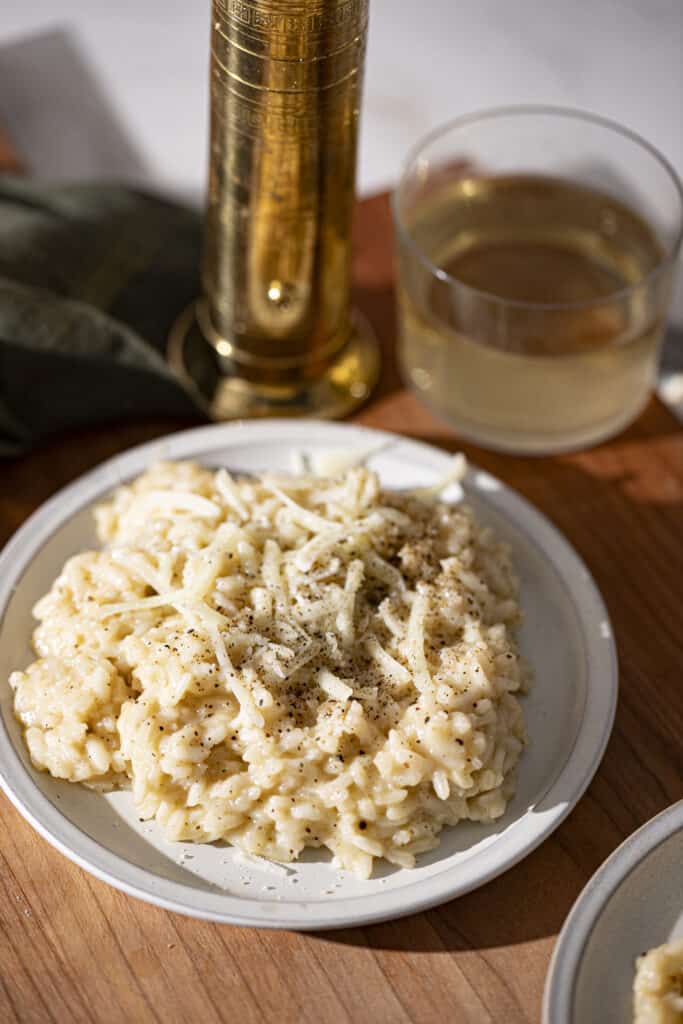
You’ll find tons of fresh grated pecorino cheese in this recipe. And, although not ingredients in cacio e pepe pasta, I also used a splash of white wine, a knob of butter, and shallot for added punch. Although this is a straightforward dish, I promise it will become one of your new Italian favorites.
When developing this recipe, I wanted to capture the taste of traditional cacio e pepe in a risotto version—the risotto’s richness pairs well with the grassy, earthy flavor of the pecorino romano cheese. If you have any questions about this risotto recipe, please leave me a note in the comment section past the recipe card. I’ll make sure to respond quickly.
My cacio e pepe risotto is the ultimate comfort food with a creamy consistency and tender arborio rice simmered in a delicious chicken broth over low heat. If you’re a fan of cacio e pepe, try my Pink Peppercorn Cacio e Pepe made with goat butter!
Table of Contents
What is Cacio e Pepe, and Where Does It Come From?
Cacio e pepe is a classic Italian pasta dish that originated in Rome. The name translates to “cheese and pepper” in English. The dish is simple yet flavorful, typically made with spaghetti, Pecorino Romano cheese, black pepper, and pasta cooking water. Its origins are unclear, but it has become a popular and iconic dish in Roman cuisine.
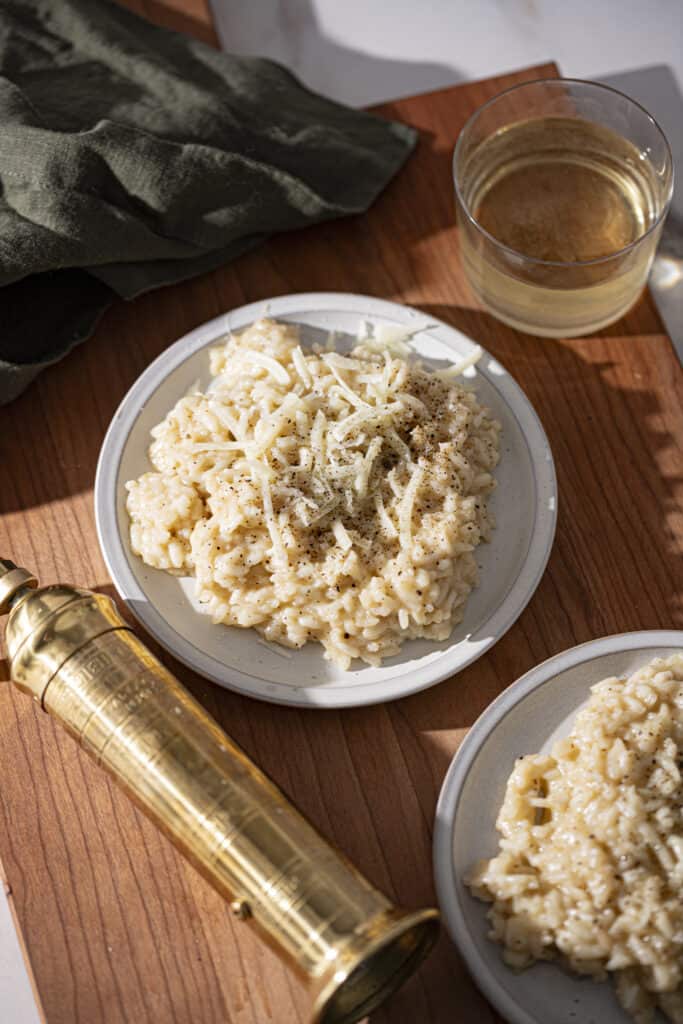
Why You’ll Love This Recipe
- A modern twist on a Roman classic – Combining the classic cacio e pepe flavors with the creamy risotto texture adds a unique twist to the traditional pasta dish. This fusion of Italian culinary elements can intrigue readers who enjoy inventive recipes.
- Rich and creamy texture – Risotto is known for its rich and creamy consistency. Combined with the sharpness of Pecorino Romano cheese and the warmth of black pepper, it creates a luxurious and indulgent dish that can appeal to those who appreciate comfort food.
- Complex flavors – Combining Pecorino Romano and black pepper in cacio e pepe brings a bold and complex flavor profile. When incorporated into risotto, these flavors may intermingle with the creamy rice, offering a sophisticated and satisfying taste experience.
Ingredients
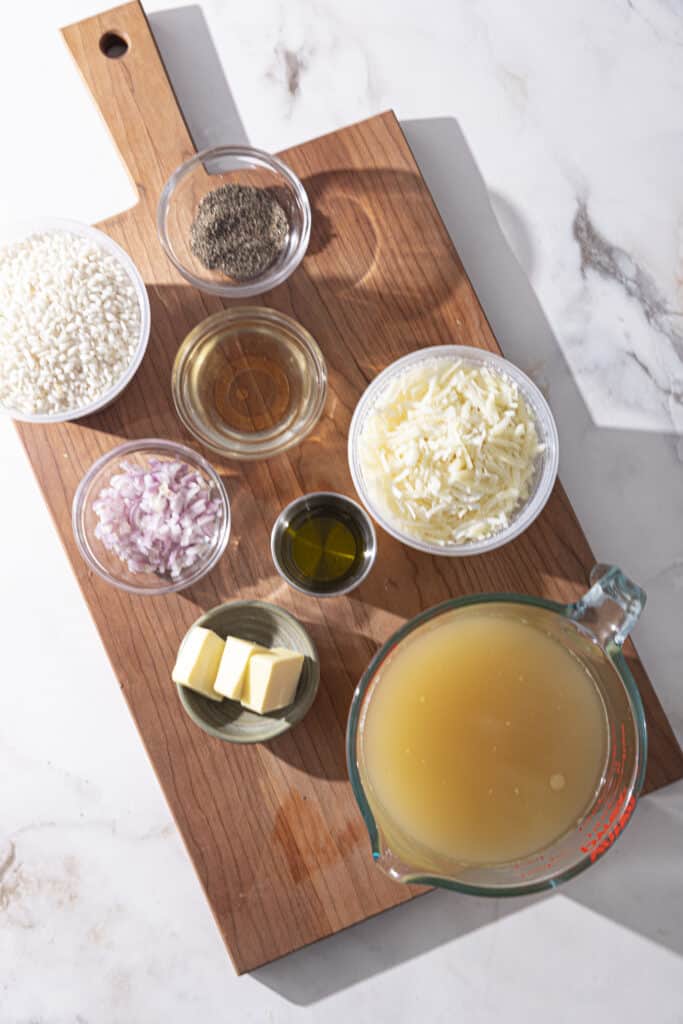
- Unsalted butter – Adds richness and a velvety texture to the risotto, contributing to its creamy consistency while allowing you to control the overall salt content of the dish.
- Olive oil – Infuses a subtle fruity flavor and contributes to the dish’s mouthfeel. Its low smoking point makes it ideal for sautéing the shallots and rice without overpowering the delicate flavors.
- Shallot – Imparts a mild, sweet onion flavor to the risotto, enhancing its aromatic profile and serving as a flavorful base for the dish.
- Arborio Rice – Known for its high starch content, Arborio rice releases starch during cooking, creating a creamy texture. Its ability to absorb flavors makes it an ideal choice for risotto dishes.
- Dry white wine – Adds a layer of acidity and complexity to the risotto, deglazing the pan and enhancing the flavor profile with a subtle wine undertone.
- Chicken broth – Serves as the liquid base for cooking the rice, infusing it with savory notes. Choosing a good-quality chicken broth can significantly impact the final taste of the risotto.
- Pecorino Romano cheese – Offers a bold and salty flavor to the risotto, providing the distinctive taste of cacio e pepe. Its sharpness complements the creaminess of the dish and adds a unique character.
- Black pepper – A crucial element in cacio e pepe, black pepper brings warmth and a pungent kick to the risotto. The freshly ground pepper adds bursts of flavor, enhancing the overall taste experience.
- Salt – Used sparingly due to the saltiness of Pecorino Romano, it helps balance the dish by bringing out the other flavors without overshadowing the natural saltiness of the cheese.
Substitutions
- Shallot – Yellow onions can be used as a substitute. The flavor profile will be slightly different, but it will still provide a savory base.
- Dry white wine – Chicken or vegetable broth can be used as a substitute for wine. Add a splash of white wine vinegar for acidity if needed. In this case, if you’d like, you can omit the wine, and that’s okay!
- Pecorino Romano cheese – Grated Parmesan cheese is a common substitute. It has a milder flavor, so you may want to adjust quantities based on taste preferences.
- Arborio Rice – While Arborio rice is traditional for risotto, you can use other short-grain varieties like Carnaroli or Vialone Nano. They have similar starch content and work well for creamy risotto.
Step by Step Instructions
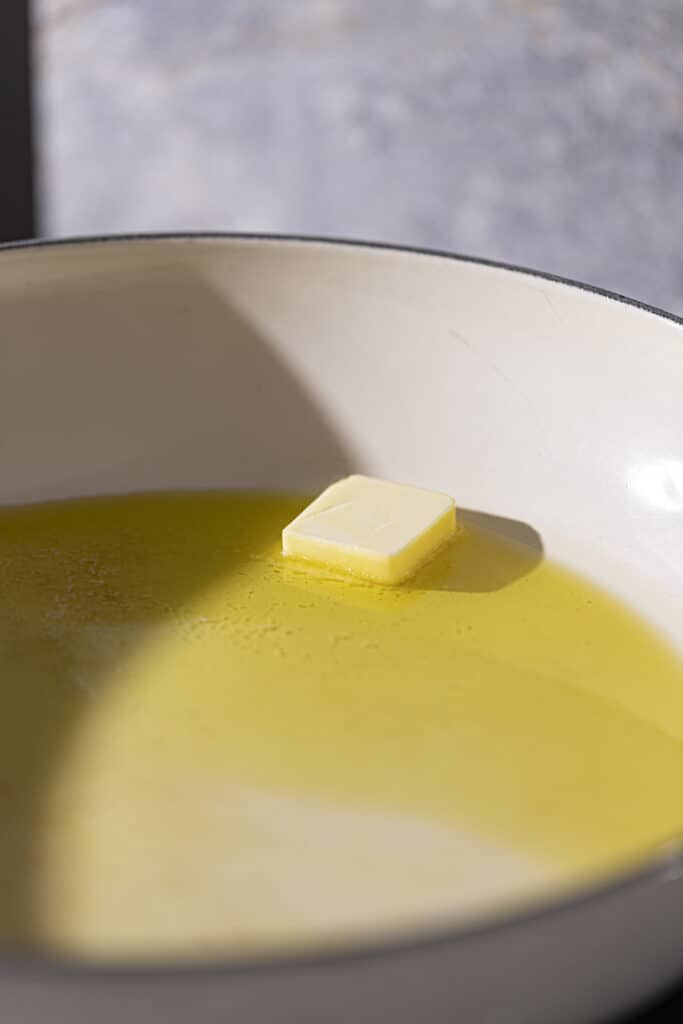
Step 1: In a large, heavy-bottomed pan, heat 2 tbsp olive oil and melt 1 tbsp butter over medium heat.
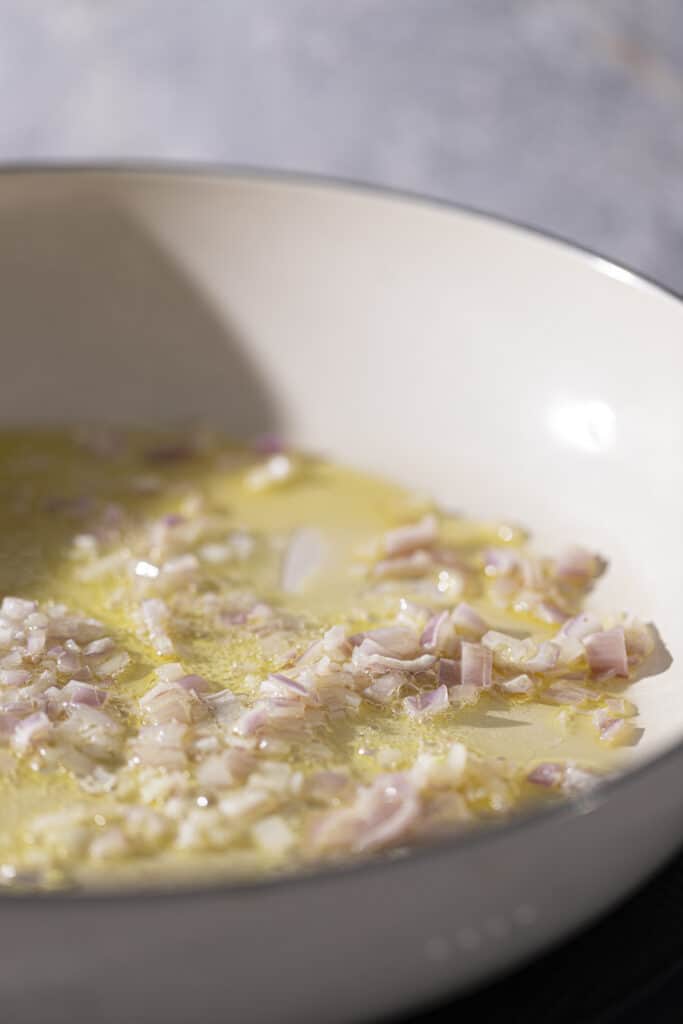
Step 2: Add the minced shallot and sauté until softened and translucent.
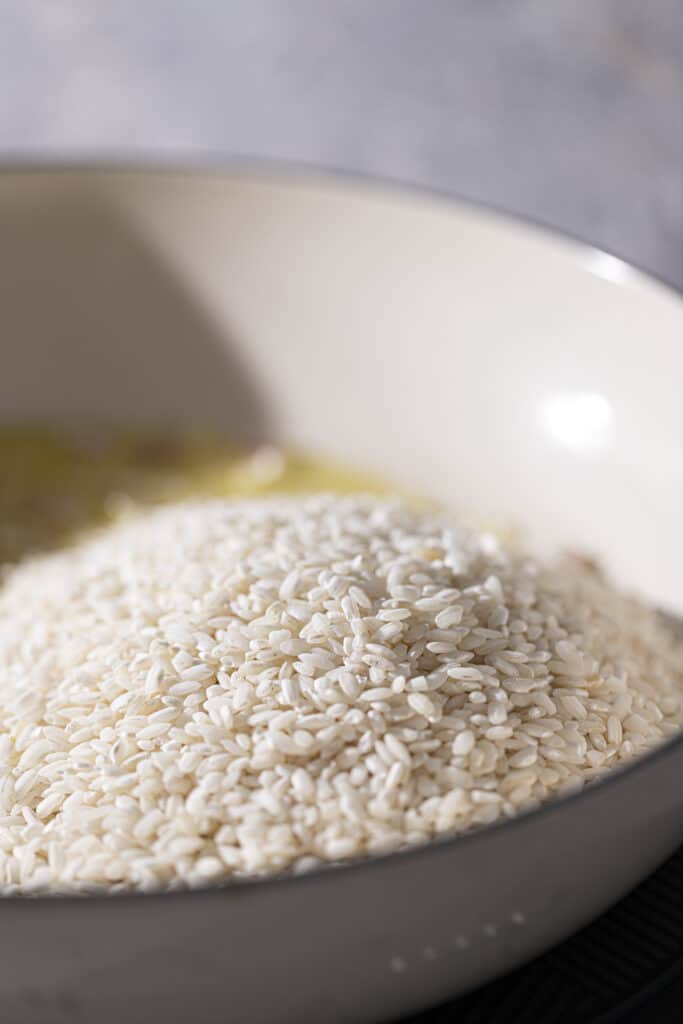
Step 3: Stir in the Arborio rice, ensuring each grain is coated with the oil and butter.
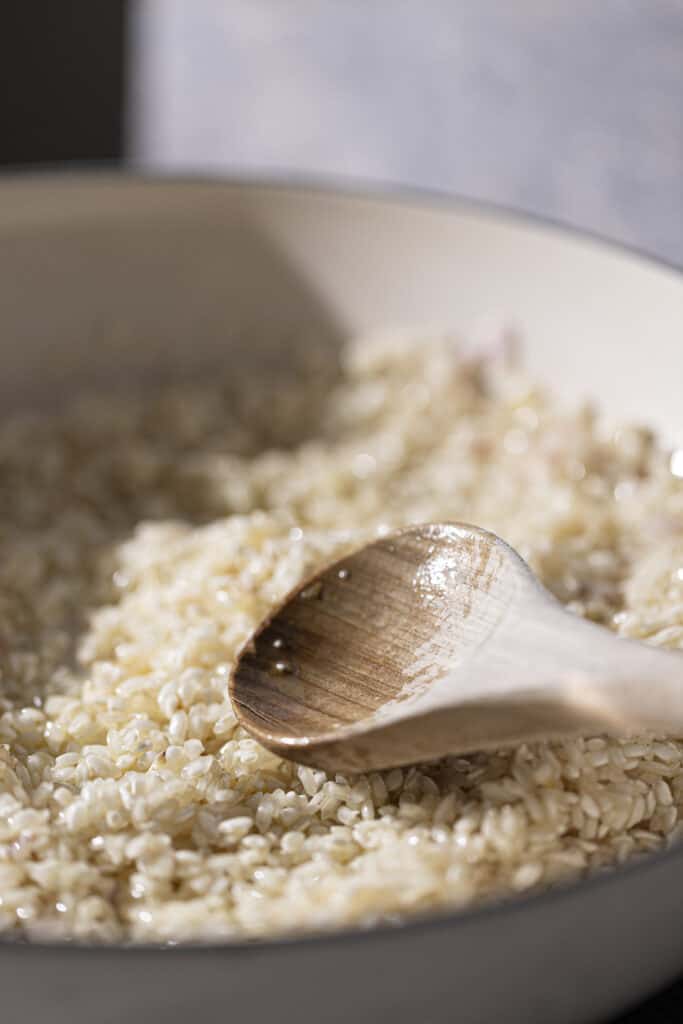
Step 4: Sauté for 2-3 minutes until the edges of the rice become slightly translucent. Pour in the dry white wine and cook until the wine is mainly absorbed by the rice, stirring constantly.
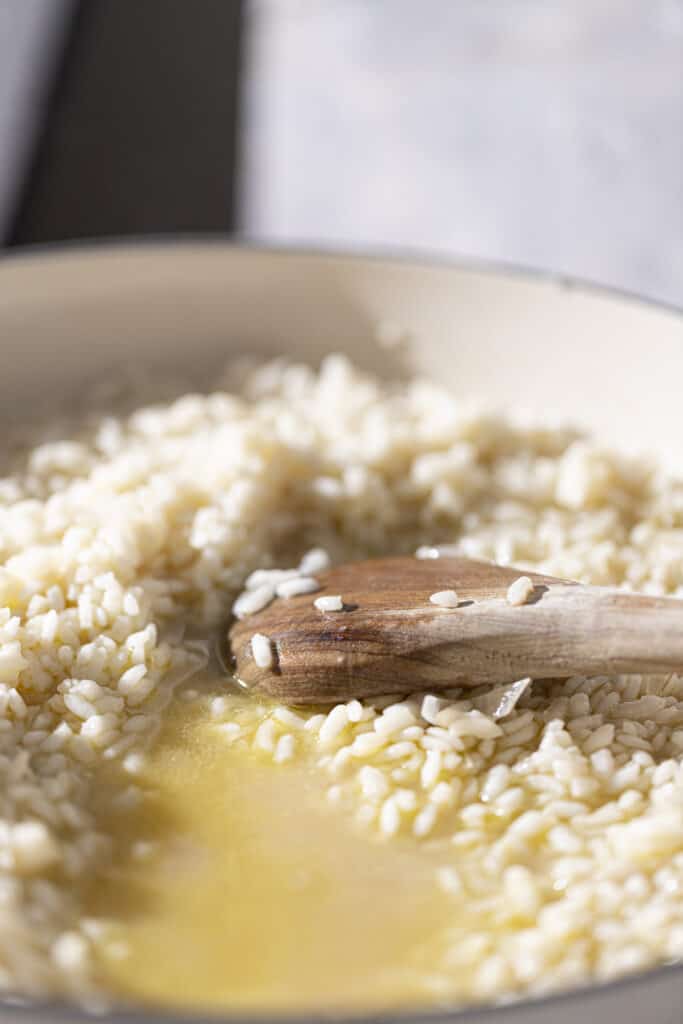
Step 5: Add the chicken broth, one ladle at a time, allowing the liquid to be absorbed before adding the next ladle. Stir frequently to ensure the rice cooks evenly.

Step 6: Continue this process until the rice is creamy and cooked to al dente texture. This should take about 18-20 minutes. Adjust the heat as needed to maintain a gentle simmer. Then, once the rice is done cooking, take the pan off the heat and add the Pecorino Romano cheese.
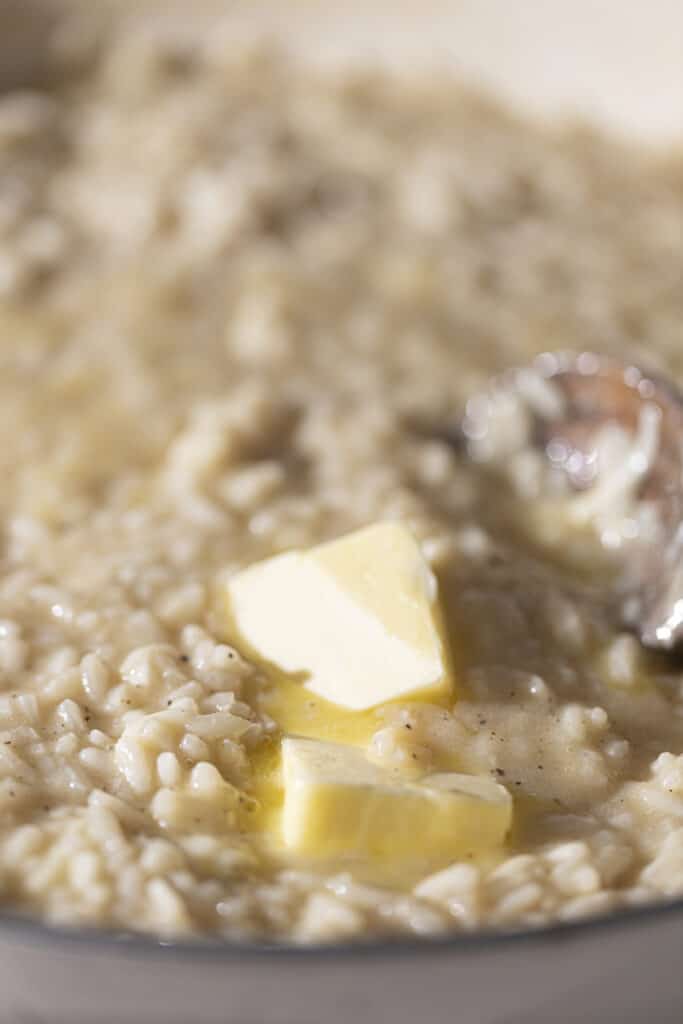
Step 7: Stir in the remaining 2 tbsp of butter, freshly ground black pepper, and salt. Mix well until the cheese is melted and the risotto is creamy.
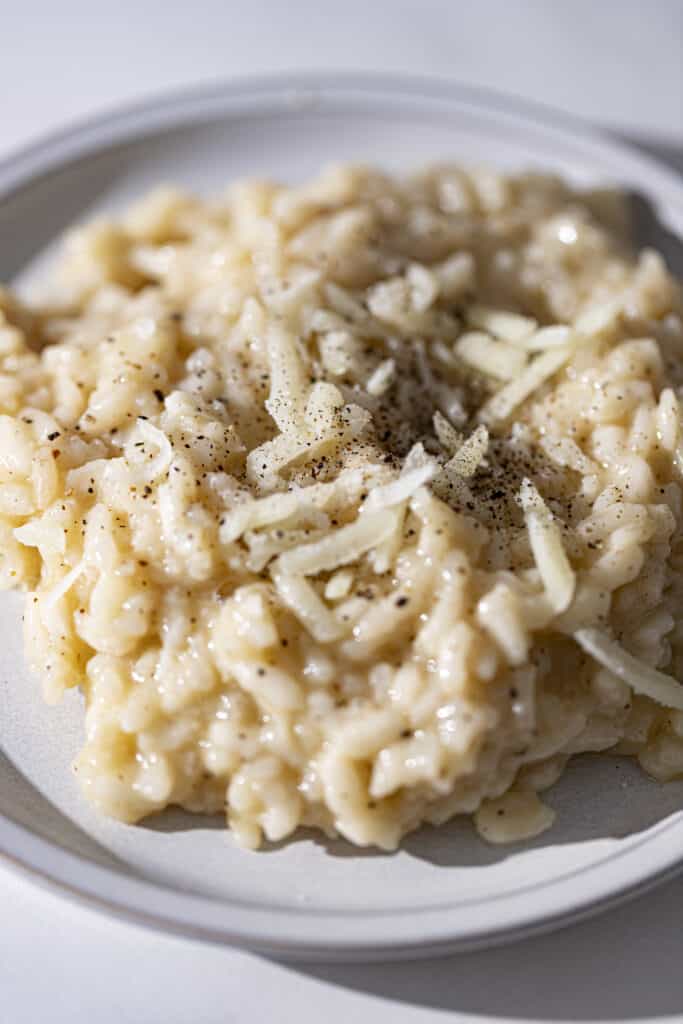
Step 8: Taste and adjust seasoning if necessary. The risotto should have a creamy consistency and a balance of salty, cheesy, and peppery flavors.
Serve the cacio e pepe risotto hot, garnished with additional Pecorino Romano and a sprinkle of black pepper if desired.
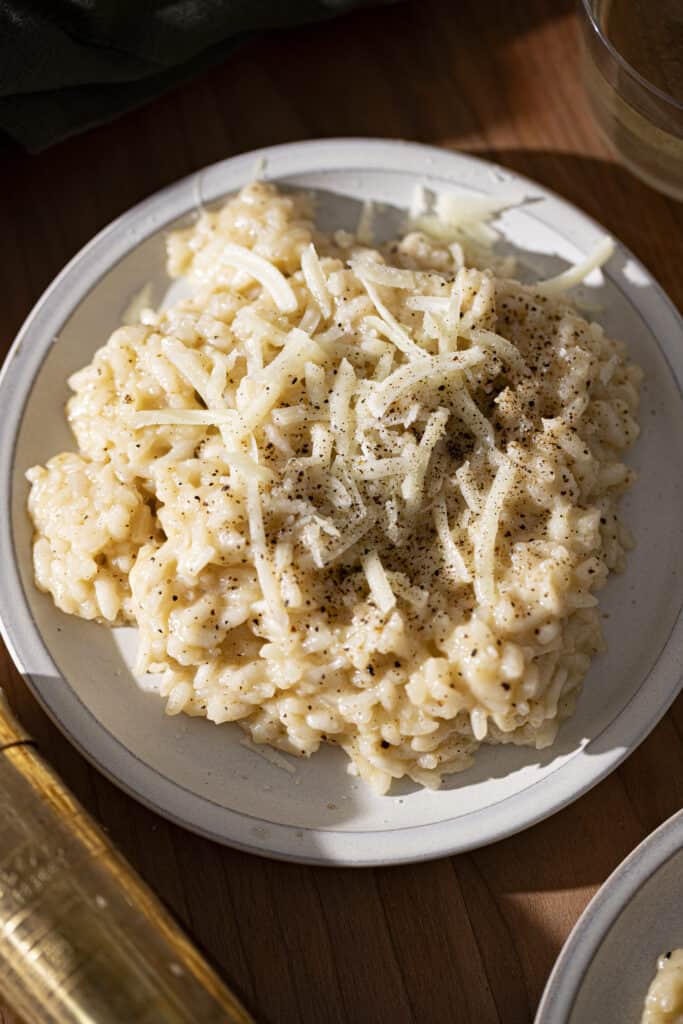
Tips and Notes
- Consistent stirring – Stir the risotto frequently during the cooking process. This helps release the starch from the rice, creating a creamy texture. Be patient and allow the liquid to be absorbed before adding more.
- Quality ingredients – Use high-quality Pecorino Romano cheese for an authentic and robust flavor. Freshly ground black pepper also adds a more vibrant taste compared to pre-ground pepper.
- Wine selection – Opt for a dry white wine you enjoy drinking. The wine contributes acidity and depth to the dish, so choose one with flavors that complement the Pecorino Romano. I usually use Pinot Grigio for this recipe.
- Maintain a gentle simmer – Keep the heat at a level that maintains a gentle simmer throughout the cooking process. This gradual absorption of liquid is crucial for achieving the desired risotto texture.
- Serve immediately – Risotto is best enjoyed immediately after cooking while it’s still creamy and flavorful. If needed, add a bit more warm broth before serving to adjust the consistency.
Recipe FAQs
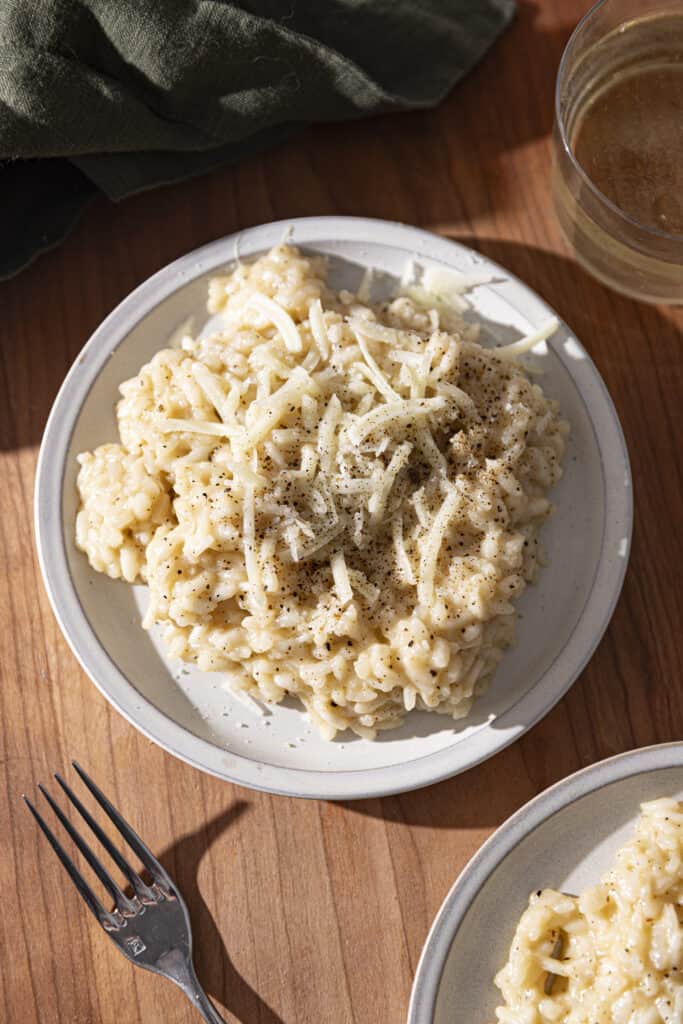
Serving Suggestions
- Wine pairing – Pair your cacio e pepe risotto with a crisp and dry white wine. A Pinot Grigio, Sauvignon Blanc, or an unoaked Chardonnay would complement the creamy texture and enhance the dish’s flavors. The wine’s acidity can balance the richness of the risotto.
- Serve it with grilled chicken breast – Serve a perfectly grilled chicken breast alongside the cacio e pepe risotto for a complete and satisfying meal. The simplicity of the chicken allows the risotto’s rich flavors to shine.
- Add roasted vegetables – Roasted vegetables, such as cherry tomatoes, asparagus, or mushrooms, complement the creamy risotto with their savory and caramelized flavors. The combination adds a delightful contrast in textures.
- Crispy prosciutto or pancetta – Crisp up some prosciutto or pancetta and crumble it over the risotto just before serving. The salty and crispy texture adds a delightful crunch to each bite.
- Garnish with fresh Herbs – Garnish with chopped fresh herbs such as parsley or chives to add freshness. The herbs provide a nice contrast to the richness of the risotto.
- Side salad – Serve a simple side salad with a lemon vinaigrette to lighten the meal. Arugula or mixed greens with acidity can provide a refreshing palate cleanser between bites.

Storage and Reheating Instructions
Storage
- Refrigeration – Allow any leftover cacio e pepe risotto to cool to room temperature before storing. Place it in an airtight container and refrigerate within two hours of cooking. Risotto is best when consumed within 2-3 days. Store the risotto in a container that minimizes empty space to reduce air exposure, helping maintain its quality.
Reheating
- Stovetop reheating – Place the risotto in a pan on the stovetop over medium-low heat. Add a bit of chicken broth or water to the pan to restore creaminess. Stir the risotto constantly as it reheats to prevent sticking and ensure even warming. Continue until the desired temperature is reached. Reheat the risotto gradually, adding more liquid if needed. This helps maintain its creamy texture without becoming overly mushy.
- Microwave option – Alternatively, you can reheat small portions in the microwave. Add a splash of liquid and stir at intervals to ensure even warming.
- Adjust consistency – If the risotto seems too dry after reheating, incorporate more broth or water until you achieve the desired creamy consistency.
- Avoid overheating – Be cautious not to overheat the risotto, as excessive heat can lead to a gummy texture. Reheating at a moderate temperature and stirring regularly is key.
Serve fresh – While reheated risotto is enjoyable, cacio e pepe risotto is best served freshly cooked to maintain its optimal creamy texture and flavors. Consider making smaller batches to ensure a delightful dining experience each time.
Please leave a review below if you make this recipe! And, don’t forget to follow @seasonedandsalted on Instagram!
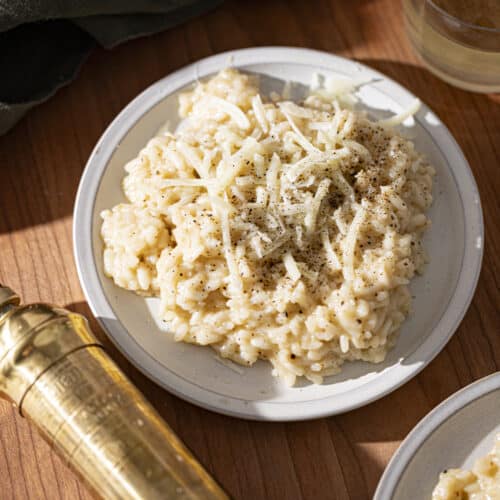
Creamy Cacio e Pepe Risotto : A Modern Italian Recipe
Equipment
- measuring spoons
- measuring cups
- Knife
- cutting board
- wooden spoon
- heavy-bottomed pot or dutch oven
- pot
- ladle
Ingredients
- 2 tablespoons olive oil
- 3 tablespoons butter for sautéing
- 2.5 tablespoons minced shallot
- 2 cups Arborio rice
- 1/2 cup dry white wine
- 5 1/2 cups chicken broth
- 2 cups shredded Pecorino Romano cheese
- 2 teaspoons black pepper freshly ground
- 1/2 teaspoon salt
Instructions
- In a large, heavy-bottomed pan, heat 2 tbsp olive oil and melt 1 tbsp butter over medium heat. Add the minced shallot and sauté until softened and translucent.
- Stir in the Arborio rice, ensuring each grain is coated with the oil and butter. Sauté for 2-3 minutes until the edges of the rice become slightly translucent. Pour in the dry white wine and cook until the wine is mainly absorbed by the rice, stirring constantly.
- Add the chicken broth, one ladle at a time, allowing the liquid to be absorbed before adding the next ladle. Stir frequently to ensure the rice cooks evenly.
- Continue this process until the rice is creamy and cooked to al dente texture. This should take about 18-20 minutes. Adjust the heat as needed to maintain a gentle simmer.
- Once the rice is cooked, stir in the remaining 2 tbsp of butter, shredded Pecorino Romano cheese, freshly ground black pepper, and salt. Mix well until the cheese is melted and the risotto is creamy.
- Taste and adjust seasoning if necessary. The risotto should have a creamy consistency and a balance of salty, cheesy, and peppery flavors.
- Serve the cacio e pepe risotto hot, garnished with additional Pecorino Romano and a sprinkle of black pepper if desired.
Notes
- Quality ingredients – Use high-quality Pecorino Romano cheese for an authentic and robust flavor. Freshly ground black pepper also adds a more vibrant taste compared to pre-ground pepper.
- Wine selection – Opt for a dry white wine you enjoy drinking. The wine contributes acidity and depth to the dish, so choose one with flavors that complement the Pecorino Romano. I usually use Pinot Grigio for this recipe.
- Serve immediately – Risotto is best enjoyed immediately after cooking while it’s still creamy and flavorful. If needed, add a bit more warm broth before serving to adjust the consistency.


So delicious and so easy to make!
This cacio e pepe risotto is unbelievable!
My new go-to risotto recipe!